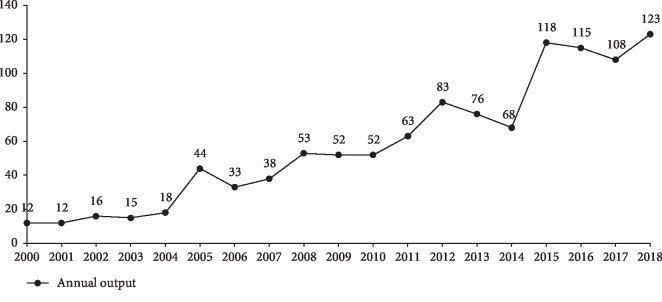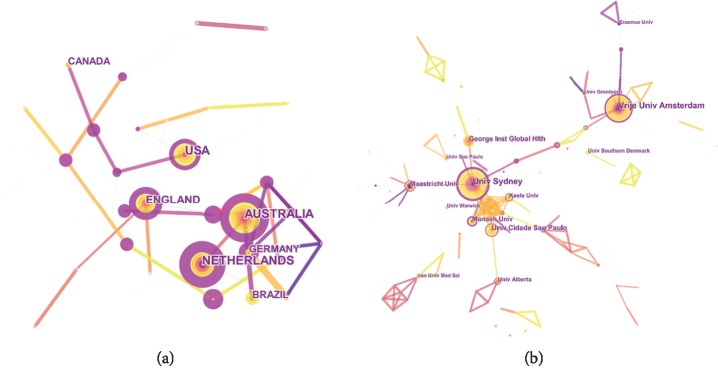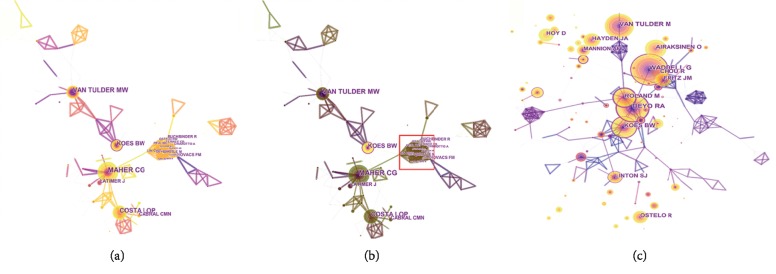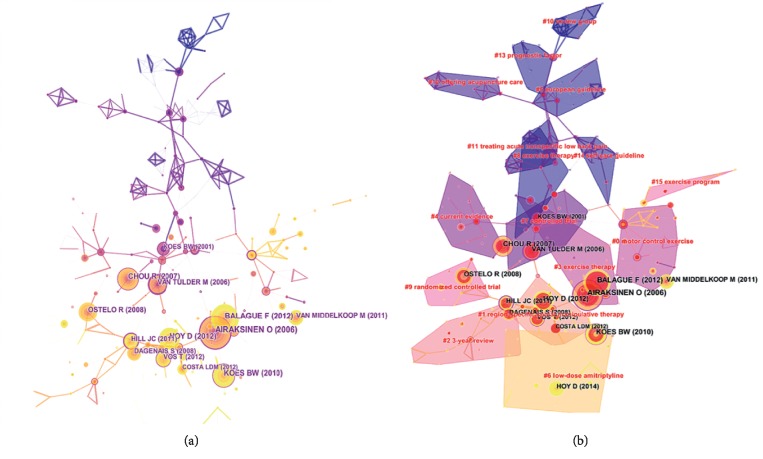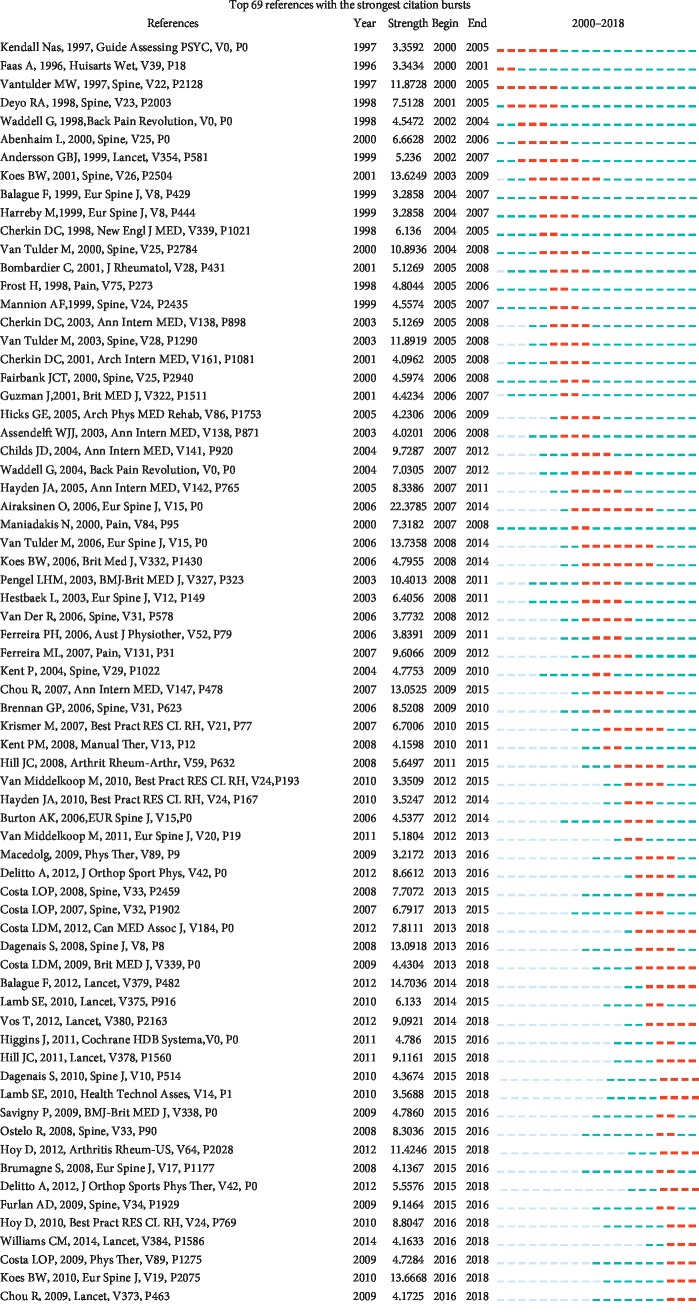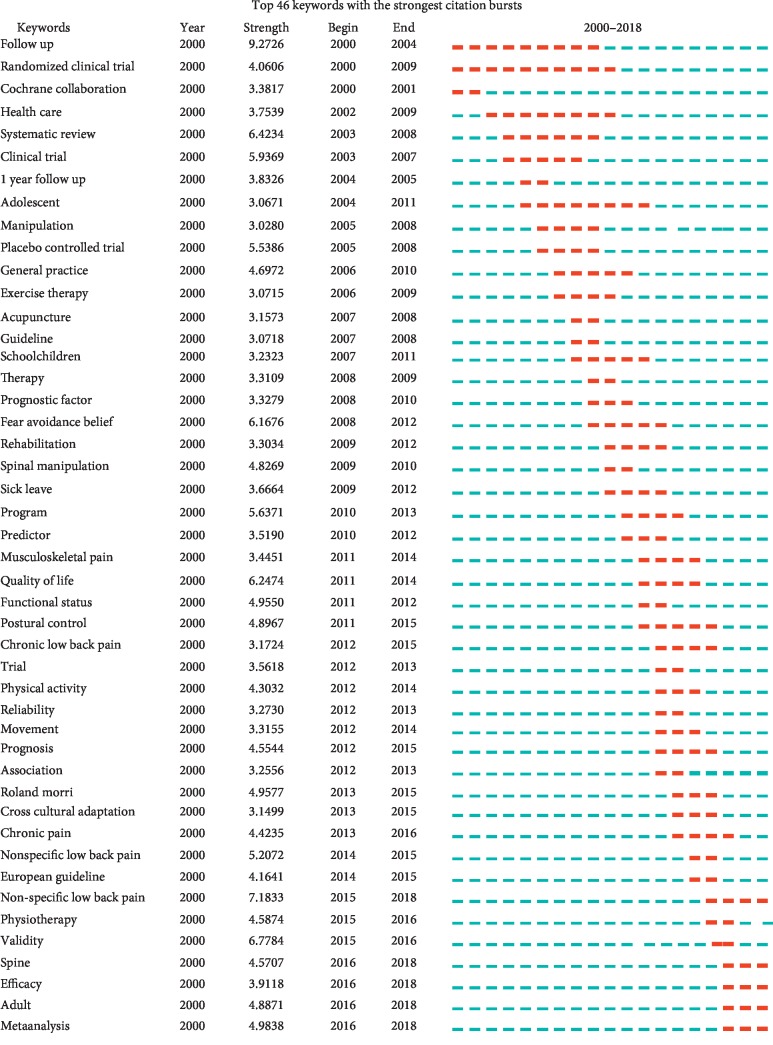Abstract
Background
Researchers are highly interested in the study of nonspecific low back pain (NSLBP). However, few have attempted to collect global data, analyze the emerging trends, and conduct reviews from the perspectives of visualization and bibliometrics.
Purpose
We aimed to evaluate research situation and capture subsequent developmental dynamics regarding NSLBP via CiteSpace.
Methods
Publications on NSLBP in recent 19 years were retrieved from the Web of Science Core Collection (WoSCC). We used CiteSpace to analyze publication outputs, document types, countries, institutions, journals, authors, references, and keywords. Knowledge foundation, hot topics, and future direction were then stated.
Results
A total of 1099 papers were collected, and the trend of annual publications maintained growth with small fluctuations. Australia (188) and the University of Sydney (76) were the most prolific country and institution, respectively. The Netherlands (0.84) and the University of Sydney (0.47) had the maximum centrality, thus indicating that they have importance in this field. The journal Spine (publication: 87, cocitation counts: 942) ranked first in terms of the volume of publications and cocitation counts. Maher CG (52) who published the most papers and Waddell G (286) who was cited most frequently were the leading authors, thus making strong academic influences. “Motor control exercise” was the largest cluster, which contained most related research articles. 14 references with the strongest citation counts were cited until 2018, thus implying the future development trend. Current hotspots were treatment, meta-analysis, method, and risk factors. Spine, efficacy, adult, and meta-analysis can be regarded as research frontiers.
Conclusion
This study offers insights into the trend of NSLBP to determine major research countries and institutions, core journals, pivotal authors, overall development tendency, hot topics, and research frontiers. Moreover, it will help researchers extract hidden valuable information for further study.
1. Introduction
Nonspecific low back pain (NSLBP), without a recognizable pathogeny, has been reported as the major kind of low back pain (LBP) with a high proportion of 90–95% [1, 2]. On a global scale, LBP was the top cause of disability, ahead of other 290 diseases [3–5]. The public health care issues incurred as a result of NSLBP are enormous and costly in most countries [6, 7]. This pain contributes to high pain intensity, depression, functional impairment, and reduced quality of life [8]. Work absence alone caused by NSLBP costs millions of dollars worldwide [9]. As reported, the total costs of LBP are approximately US $100 billion in the USA [10] and AUD $9.17 billion in Australia [11].
In view of the high incidence of NSLBP, a growing number of researchers have studied NSLBP, and relevant articles have been published in academic journals. Nevertheless, few studies on NSLBP have collected global data and conducted a large-scale retrospective analysis through bibliometrics [12–14].
Bibliometrics is a quantitative analysis of published academic literature on a particular topic [15]. Based on citation counts that indicate the impact of a paper on the scientific community, it can conduct an in-depth evaluation of the literature and its references [16, 17]. This analysis is effective and convenient for assessing the productivity of authors, countries, and institutions; identifying geographic distributions and cooperative relations; and uncovering the knowledge structure and development trends [18, 19]. Moreover, the visualization also can excavate valuable information by data-mining technology and display it intuitively [20]. Bibliometric analysis has been widely conducted in various areas, such as neurogenic bladder [21], long noncoding RNA [22], cancer [23], and pain [14, 24–26]. Liang et al. performed a bibliometric analysis to evaluate the emerging trends and hotspots on the area of acupuncture for LBP from 1997 to 2016 [24]. Balague et al. completed systematic analysis and evaluation of NSLBP [6]. On this basis, vital characteristics of this field can be explored via bibliometrics and visualization.
To address the deficiency in quantitative analysis in the study of NSLBP, the aim is to systematically explore the trends of scientific research in this field from 2000 to 2018. Web of Science (WoS) was chosen as the database for mining corresponding literature, and CiteSpace V was applied for visualizing cocitation networks and deep analyzing [27]. Combining citations and inherent relation among literatures, we could obtain some specific influential documents, evaluate current research situation, capture subsequent developmental dynamics regarding NSLBP, and provide researchers with valuable information to facilitate cooperation.
2. Methods
2.1. Source and Search Strategy
WoS contained abundant information, such as abstracts, references, citation data, and so on, so we chose the Science Citation Index Expanded (SCI-EXPANDED), Social Sciences Citation Index (SSCI), Arts & Humanities Citation Index (A&SCI), and Emerging Sources Citation Index (ESCI) of the Web of Science Core Collect (WoSCC). We used the key words “nonspecific low back pain” and its different expressions as the theme to retrieve relevant literature. Basic information for each article was gathered into text documents, such as countries, institutions, journal sources, authors, and references. The retrieval strategy was as follows: TS=(“non specific low back pain” OR “nonspecific low back pain” OR “non-specific low back pain” OR “nslbp”). No restrictions were imposed on language or document type.
2.2. Inclusion Criteria
The literature meets the following criteria: (1) literature published between 2000 and 2018; (2) literature indexed in SCI-E, SSCI, A&SCI, and ESCI of WoSCC; and (3) literature on NSLBP. We performed the data acquisition on December 8, 2018, and collected 1099 papers.
2.3. Analysis Tool
CiteSpace V, broadly recognized as a superior scientometric analysis tool, was applied to conduct statistically analyses on the literatures. The analyses drew a series of progressive visualization knowledge domains to detect emerging trends, hidden implications, and landmark literature. On the basis of cocitation maps, we performed cluster analysis and citation burst. In the maps, a large node indicated high occurrence or citation frequency of the object. Different colors represented different years. A node with a red circle in the center, called a burst node, meant that the counts of co-occurrence or citation increased sharply in a certain period. A node with a purple circle in the outline referred to turning points with high centrality and occupied key positions in the knowledge network [27, 28].
3. Results and Discussion
3.1. Analysis of Publication Outputs
The distribution in the last 19 years of annual publications showed a continuous and unstable rising trend in general. As shown in Figure 1, 2000 to 2004 could be seen as the first phase, and its development trend was steady and barely growing, with the average annual publication being 14.6. 2005 to 2014 could be seen as the second phase, which grew slowly and showed fluctuations, with an average annual publication of 56.2. 2015 to 2018 could be seen as the third phase, which showed a nonobvious changing range, with an average annual publication of 116. The annual output of the third stage was 7.9 times as productive as the first stage. In accordance with the analysis of the line chart, the overall growth trend during the study period predicted a continual increase in the next few years. Additionally, this result indicated that the research intensity is increasing, and researchers developed considerable interest in NSLBP. The publications between 2004 and 2005 and between 2014 and 2015 increased sharply. Some articles published before 2004 and 2014 attracted wide research attention and were cited frequently as the basis, thereby producing significant influence in the field.
Figure 1.
Annual output of NSLBP from 2000 to 2018.
3.2. Analysis of Document Type
Seven document types existed in total (Table 1). Almost all the papers were written in the form of article, which was the most prevalent document type, accounting for 76.62%. The next was review (13.92%) and editorial material (3.93%). “Non-specific low back pain” was the article that had the most citation frequency. The article mentioned that the all-life morbidity rate of LBP was up to 84% and approximately 1 in 10 people had disability due to LBP [6]. “Diagnosis and treatment of low back pain: A joint clinical practice guideline from the American College of Physicians and the American Pain Society” was the most cited review, which recommended that clinicians needed to advise patients with LBP to keep moving and look after themselves in proactive and appropriate measures [29].
Table 1.
Types of literature on NSLBP.
| Ranking | Document type | Count | Percentage (%) |
|---|---|---|---|
| 1 | Article | 842 | 76.62 |
| 2 | Review | 153 | 13.92 |
| 3 | Editorial material | 43 | 3.93 |
| 4 | Meeting abstract | 31 | 2.82 |
| 5 | Letter | 22 | 2.00 |
| 6 | Proceedings paper | 11 | 1.00 |
| 7 | Correction | 6 | 0.73 |
3.3. Analysis of Country
Table 2 shows the top 10 countries researching the trends of NSLBP; Australia was the most productive country, accounting for 17.11%, followed by the Netherlands (16.02%) and the USA (14.74%). The top four countries' contributions were all above 10%, which indicated that they contributed major shares in research achievements.
Table 2.
Top 10 countries and institutions in the study of NSLBP from 2000 to 2018.
| Ranking | Country | Publications | Percentage (%) | Centrality | Institution | Publications | Percentage (%) | Centrality |
|---|---|---|---|---|---|---|---|---|
| 1 | Australia | 188 | 17.11 | 0.66 | University of Sydney | 76 | 6.92 | 0.47 |
| 2 | Netherlands | 176 | 16.02 | 0.84 | Vrije Universiteit Amsterdam | 71 | 6.46 | 0.20 |
| 3 | USA | 162 | 14.74 | 0.33 | Maastricht University | 34 | 3.09 | 0.14 |
| 4 | England | 141 | 12.83 | 0.49 | Universidade Cidade de Sao Paulo | 32 | 2.91 | 0.14 |
| 5 | Brazil | 91 | 8.28 | 0.00 | George Institute for Global Health | 31 | 2.82 | 0.09 |
| 6 | Germany | 84 | 7.64 | 0.50 | Monash University | 25 | 2.28 | 0.22 |
| 7 | Canada | 81 | 7.37 | 0.00 | Keele University | 20 | 1.82 | 0.11 |
| 8 | Switzerland | 66 | 6.01 | 0.66 | University of Groningen | 20 | 1.82 | 0.02 |
| 9 | Spain | 65 | 5.91 | 0.02 | Erasmus University | 19 | 1.73 | 0.03 |
| 10 | Belgium | 50 | 4.55 | 0.00 | University of Alberta | 18 | 1.64 | 0.13 |
The network map of country cooperation was generated by CiteSpace V with 43 nodes and 50 links (Figure 2(a)). The Netherlands had the maximum centrality (0.84); it was followed by Australia (0.66) and Switzerland (0.66). According to the definition of centrality, these countries showed comparably close collaborations with others and strong academic influence. The comprehensive analysis of publication and centrality indicated that Australia and the Netherlands were in the dominant positions. The Netherlands, Australia, Austria, Bangladesh, Germany, and Switzerland formed Netherland-centered and strong partnerships. Some prolific countries, such as Brazil, Canada, and Belgium, showed no coincidental centrality that the value is 0. Furthermore, they have not performed extensive academic exchanges and cooperation with international counterparts; thus, they occupied a marginal status.
Figure 2.
The analysis of countries and institutions. (a) Network map of country cooperation in NSLBP research from 2000 to 2018. (b) Network map of institution cooperation in NSLBP research from 2000 to 2018.
3.4. Analysis of Institution
From Table 2, the University of Sydney was the leading institution researching the trends of NSLBP, accounting for 6.92%, followed by Vrije Universiteit Amsterdam (6.46%) and then Maastricht University (3.09%). The top two institutions' proportions were both above 5%, thus indicating that they accomplished relatively substantial research achievements and certain research strengths.
The network map of institution cooperation was generated by CiteSpace V with 216 nodes and 296 links (Figure 2(b)). The University of Sydney showed maximum centrality (0.47). The next was Monash University (0.22) and George Institute for International Health (0.21). These institutions showed a comparably broad range of cooperation with others and a strong academic influence. In terms of publication and centrality, the University of Sydney and Vrije Universiteit Amsterdam were the core strengths and conducted major cooperative position. The strongest partnerships were identified among the University of Sydney, Maastricht University, George Institute for International Health, George Institute for Global Health, and Oslo University Hospital.
3.5. Analysis of Journals
Table 3 lists a range of journals that published the most articles on NSLBP from 2000 to 2018. Spine accounts for the most outputs (7.92%), followed by European Spine Journal (6.19%) and BMC Musculoskeletal Disorders (5.82%). In contrast to other journals, the top three journals' proportions were all above 5%, thus signifying that they were authoritative and had a special position. Only one journal's impact factors exceeded 5, whereas the remaining average impact factor was 2.181. Writing in a high-impact-factor journal could be considered challenging. “Exercise therapy for low back pain—A systematic review within the framework of the Cochrane Collaboration back review group” published in Spine was cited over 300 times until 2018. This review indicated that exercise therapy might be beneficial to relieve chronic LBP and help patients return to home and society; however, it did not play a notable role in acute LBP by testing the effectiveness of multifarious exercise treatments for participants who had NSLBP with and without radiation into their legs [30]. “Exercise therapy for treatment of non-specific low back pain” in Cochrane Database of Systematic Reviews, which was cited the most, also proved the same results that exercise therapy exhibited equal effectiveness with no treatment or conservative treatment for acute LBP, and it exerted slight effects for chronic LBP [31].
Table 3.
Top 10 journals and cocited journals in the study of NSLBP from 2000 to 2018.
| Ranking | Journal | Publication | Percentage (%) | IF (2018) | Cited journal | Cocitation counts |
|---|---|---|---|---|---|---|
| 1 | Spine | 87 | 7.92 | 2.792 | Spine | 942 |
| 2 | European Spine Journal | 68 | 6.19 | 2.634 | Pain | 644 |
| 3 | BMC Musculoskeletal Disorders | 64 | 5.82 | 1.998 | European Spine Journal | 618 |
| 4 | Journal of Back and Musculoskeletal Rehabilitation | 29 | 2.64 | 0.982 | Physical Therapy | 472 |
| 5 | Manual Therapy | 27 | 2.46 | 2.330 | Lancet | 391 |
| 6 | Physical Therapy | 27 | 2.46 | 2.587 | British Medical Journal | 363 |
| 7 | Journal of Manipulative and Physiological Therapeutics | 24 | 2.18 | 1.426 | Clinical Journal of Pain | 349 |
| 8 | Cochrane Database of Systematic Reviews | 20 | 1.82 | 6.754 | Archives of Physical Medicine and Rehabilitation | 341 |
| 9 | Archives of Physical Medicine and Rehabilitation | 17 | 1.55 | 3.077 | BMC Musculoskeletal Disorders | 341 |
| 10 | Journal of Rehabilitation Medicine | 17 | 1.55 | 1.802 | Manual Therapy | 316 |
The network map of cocitation journal was generated by CiteSpace V with 187 nodes and 190 links (Figure 3). Spine had the maximum cocitation counts (942). The next was Pain (644) and European Spine Journal (618) (Table 3). The high cocitation counts implied that these journals had superior quality and academic influence relatively and were recognized and undisputed as mainstream. The comprehensive analysis of the publication and cocitation counts showed that Spine and European Spine Journal were the core journals in the field.
Figure 3.
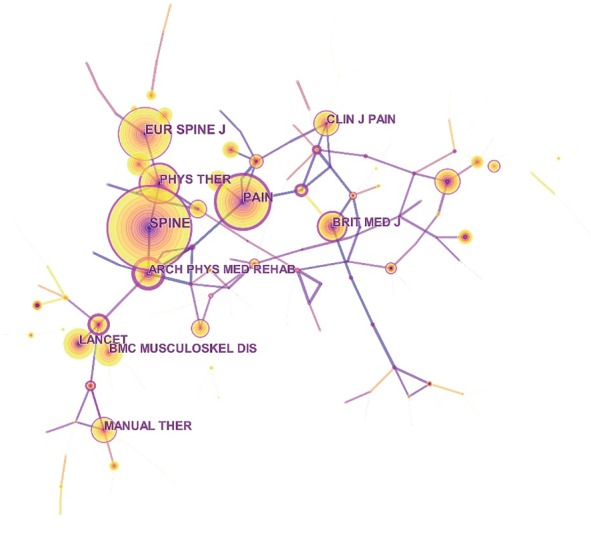
Network map of cocited journals in NSLBP research from 2000 to 2018.
3.6. Analysis of Author, Coauthor, and Cocited Author
In Table 4, Maher CG ranks first in terms of publications and accounts for 4.73%, followed by Van Tulder MW (3.46%) and Coast LOP (3.37%). Macher CG and his team explored in accordance with the comparison of the effects of various exercises or physical therapies (such as motor control exercise, spinal manipulative therapy, general exercise, graded activity, and McKenzie method) and placebo in different types of LBP, the influence of depression, the primary care management, and its prognosis.
Table 4.
Top 10 authors and cocited authors in the study of NSLBP from 2000 to 2018.
| Ranking | Author | Publications | Percentage (%) | Centrality | Cited author | Cocitation counts |
|---|---|---|---|---|---|---|
| 1 | Maher CG | 52 | 4.73 | 0.08 | Waddell G | 286 |
| 2 | Van Tulder MW | 38 | 3.46 | 0.08 | Deyo RA | 249 |
| 3 | Costa LOP | 37 | 3.37 | 0.04 | Van Tulder M | 226 |
| 4 | Koes BW | 37 | 3.37 | 0.10 | Koes BW | 194 |
| 5 | Latimer J | 21 | 1.91 | 0.00 | Roland M | 179 |
| 6 | Kool J | 19 | 1.73 | 0.00 | Airaksinen O | 164 |
| 7 | Kovacs FM | 14 | 1.27 | 0.03 | Chou R | 143 |
| 8 | Underwood M | 14 | 1.27 | 0.01 | Fritz JM | 143 |
| 9 | Bachmann S | 13 | 1.18 | 0.00 | Hayden JA | 131 |
| 10 | Cabral CMN | 13 | 1.18 | 0.00 | Ostelo R | 122 |
The network map of author cooperation was generated by CiteSpace V with 341 nodes and 606 links (Figure 4(a)). On the centrality side, Koes BW had maximum centrality (0.10). The next was Lin CWC (0.09) and Maher CG (0.08). Almost all the authors' centralities were equal to 0, thus reflecting that the collaboration among authors was weak and needed improvement. Figure 4(b) shows that the lines around nodes in red square were extensive and might mean that these authors generated a small collaboration group. Nevertheless, the area was unhighlighted after spotlight, which demonstrated that our hypothesis that strong exchanges and frequent communications occurred among these authors was wrong.
Figure 4.
The analysis of authors. (a) Network map of author cooperation in NSLBP research from 2000 to 2018. (b) Network map of author cooperation after spotlight in NSLBP research from 2000 to 2018. (c) Network map of cocited authors in NSLBP research from 2000 to 2018.
The network map of cocitation author was generated by CiteSpace V with 250 nodes and 425 links (Figure 4(c)). We also identified the top 10 cited authors according to cocitation counts. Waddell G ranked first (286), followed by Deyo RA (249) and Van Tulder M (226). The high cocitation counts hinted that these authors played a significant role and had a great influence. Their work also accelerated the development of relevant subjects. In terms of the publication and cocitation counts, Koes BW predominated in the research of NSLBP. However, only one prolific author belonged to the top 10 cocited authors, which denoted that their articles did not raise widespread concern. Koes BW and his team studied the efficacy of some interventions (such as exercise therapy, acupuncture, pharmacological treatment, and other complementary and alternative medicine), the management of primary care, risk factors, and prognosis and course in various of aspects. In one highly cited paper, they mentioned that the recommendations of diagnosis and treatment for LBP were roughly similar [32].
3.7. Analysis of Cocited References
The network map of cocitation reference was generated by CiteSpace V with 279 nodes and 401 links (Figure 5(a)), which clearly delineated scientific relevance in considerable literature. “Chapter 4—European guidelines for the management of chronic nonspecific low back pain” had the maximum cocitation counts (80). Contrary to acute LBP, chronic LBP had fewer guidelines and rather limited therapeutic effect. Encouraging patients with chronic NSLBP by cognitive behavioral interventions is the most promising method [33]. As shown in Table 5, “Non-specific low back pain” was the article which was published recently and cited frequently relatively, mentioning that most of treatments had low effect sizes and patients' preferences or views should also serve as a basis for management [6].
Figure 5.
The analysis of references. (a) Network map of cocited references in NSLBP research from 2000 to 2018. (b) Cluster view for cocited references in NSLBP research from 2000 to 2018.
Table 5.
Top five cocited references in the study of NSLBP from 2000 to 2018.
| Ranking | Cited reference | Cocitation counts | Publication year |
|---|---|---|---|
| 1 | Chapter 4—European guidelines for the management of chronic nonspecific low back pain | 80 | 2006 |
| 2 | Non-specific low back pain | 71 | 2012 |
| 3 | An updated overview of clinical guidelines for the management of non-specific low back pain in primary care | 57 | 2010 |
| 4 | Diagnosis and treatment of low back pain: A joint clinical practice guideline from the American college of physicians and the American pain society | 55 | 2007 |
| 5 | A systematic review of the global prevalence of low back pain | 55 | 2012 |
The 10 cocited references listed in the Tables 5 and 6 were fundamental articles, representing knowledge base. According to the cocitation counts and centrality, “Chapter 4—European guidelines for the management of chronic nonspecific low back pain” was the key reference. The article was cited more than 1000 times by the end of 2018, mirroring most people were beset by chronic LBP in contrast to other types. This article studied different diagnoses and treatments to judge which was necessary and beneficial [33]. These top articles revealed that NSLBP arouse researchers' attention, and several people were struggling to search for effective therapeutic methods. As for the management, primary care and exercise training were also followed with interest.
Table 6.
Top five cocited references in terms of centrality in the study of NSLBP from 2000 to 2018.
| Ranking | Cited reference | Centrality | Publication year |
|---|---|---|---|
| 1 | Chapter 3—European guidelines for the management of acute nonspecific low back pain in primary care | 0.57 | 2006 |
| 2 | Meta-analysis: exercise therapy for nonspecific low back pain | 0.46 | 2005 |
| 3 | Clinical importance of changes in chronic pain intensity measured on an 11-point numerical pain rating scale | 0.44 | 2001 |
| 4 | Chapter 4—European guidelines for the management of chronic nonspecific low back pain | 0.38 | 2006 |
| 5 | Motor control exercise for chronic low back pain: a randomized placebo-controlled trial | 0.36 | 2009 |
In Figure 5(b), these articles were divided into diverse clusters labeled with title terms extracted from references. The modularity Q score was 0.8613 higher than 0.5, which meant that the definition of every subdomain and the features of knowledge clusters were distinct. The mean silhouette was 0.4993 lower than 0.5 due to the existence of small clusters that reduced the reliability of the value. A high homogeneity to individual clusters remained, which indicated high concentration on various research aspects. “Motor control exercise” was the largest cluster #0; the next was cluster #1 (region-specific spinal manipulative therapy) and cluster #2 (3-year review). Cluster #1 contained most burst references, which implied that “region-specific spinal manipulative therapy” received considerable attention and emphasized research focus in recent years. Two burst cited articles belonged to cluster #3 (exercise therapy), in which its nodes had the largest red circles, and were cited frequently in a long time; hence, exercise therapy was commonly used as remedy over a considerable period of time, probably, because it can improve muscle strength and stability and decrease pain-causing irritants [34].
The 14 references were selected in terms of its strongest citation bursts, which continued until 2018 (Figure 6, Table 7), and the citation index also would keep growing rapidly in the upcoming years. In this way, these articles partly indicated current research hotspots. With them as a basis, researchers could go a step further and predict development direction. The topic analysis suggested that meta-analysis, systematic review, and randomized controlled trial were widely applied in research. Scholars showed solicitude for the course of disability and pain in the prognostic process, the efficacy of primary care, motor exercise, cognitive behavioral therapy, and other therapeutic measures for LBP. They also mentioned that physicians should not rely on clinical imaging to diagnose [35].
Figure 6.
Top 69 references with the strongest citation bursts.
Table 7.
Fourteen references with the strongest citation bursts that continue until 2018.
| Ranking | References | Publication year | Beginning year | Ending year |
|---|---|---|---|---|
| 1 | The prognosis of acute and persistent low-back pain: a meta-analysis | 2012 | 2013 | 2018 |
| 2 | Prognosis for patients with chronic low back pain: inception cohort study | 2009 | 2013 | 2018 |
| 3 | Non-specific low back | 2012 | 2014 | 2018 |
| 4 | Years lived with disability (YLDs) for 1160 sequelae of 289 diseases and injuries 1990–2010: a systematic analysis for the Global Burden of Disease Study 2010 | 2012 | 2014 | 2018 |
| 5 | Comparison of stratified primary care management for low back pain with current best practice (STarT Back): a randomised controlled trial | 2011 | 2015 | 2018 |
| 6 | Synthesis of recommendations for the assessment and management of low back pain from recent clinical practice guidelines | 2010 | 2015 | 2018 |
| 7 | A multicentred randomised controlled trial of a primary care-based cognitive behavioural programme for low back pain. The Back Skills Training (BeST) trial | 2010 | 2015 | 2018 |
| 8 | A systematic review of the global prevalence of low back pain | 2012 | 2015 | 2018 |
| 9 | Patellofemoral pain: proximal, distal, and local factors, 2nd International Research Retreat. | 2012 | 2015 | 2018 |
| 10 | The epidemiology of low back pain | 2010 | 2016 | 2018 |
| 11 | Efficacy of paracetamol for acute low-back pain: a double-blind, randomized controlled trial | 2014 | 2016 | 2018 |
| 12 | Motor control exercise for chronic low back pain: a randomized placebo-controlled trial | 2009 | 2016 | 2018 |
| 13 | An updated overview of clinical guidelines for the management of non-specific low back pain in primary care | 2010 | 2016 | 2018 |
| 14 | Imaging strategies for low-back pain: systematic review and meta-analysis | 2009 | 2016 | 2018 |
3.8. Analysis of Keyword Co-Occurrence and Burst Keywords
The network map of keyword co-occurrence was generated by CiteSpace V with 149 nodes and 204 links (Figure 7). Table 8 presents 40 keywords with the most cocitation counts and centrality. Follow-up, low back pain, randomized controlled trial, risk factor, reliability, management, meta-analysis, exercise, questionnaire, prevalence, and rehabilitation could be regarded as popular hot keywords. Therefore, current hot topics were described.
Treatment: as a rehabilitation method, exercise therapy is the most effective and broadly concerned. For chronic NSLBP, this therapy can availably relieve pain, decrease disabled degree, and improve the body function. However, for acute NSLBP, it does not have a remarkable effect in relation to no exercise or other conservative treatment [30, 36, 37]. In addition, cognitive behavioral therapy is increasingly popular. The management of primary care also cannot be neglected.
Meta-analysis: meta-analysis is performed to evaluate the effects of sundry interventions, measure the improvement outcomes of pain and function, and return to work after interfering. This topic is restricted by low-quality literature, heterogeneous data, and inconsistent studies [24, 36, 37].
Method: randomized controlled trials are often used as research methods to provide evidences on whether treatments have any value. Follow-up, which needs to be taken advantage of, is a significant period to extract data on research findings, in which participants complete questionnaires in many scientific studies [38–40].
Risk factors: some factors (for instance, age, pain intensity, duration of disease, days of activity limitation, and emotion) may affect the prognosis, lead to severe disability or pain, and develop chronicity [38, 41].
Figure 7.
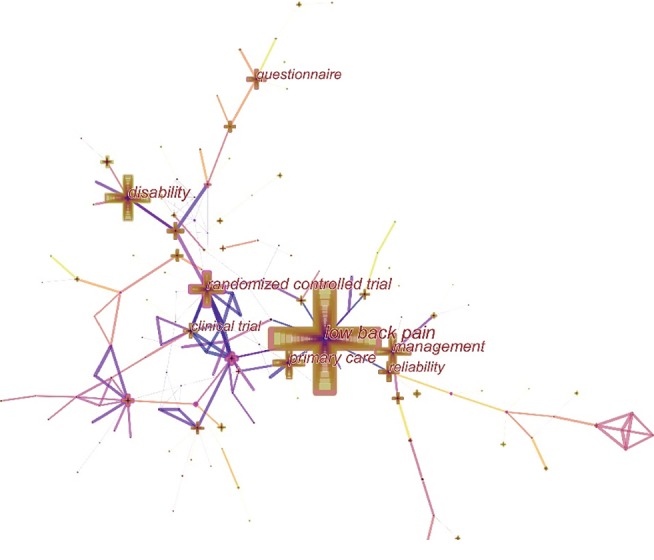
Network map of keyword co-occurrence in NSLBP research from 2000 to 2018.
Table 8.
Top 20 keywords in terms of frequency and centrality in the study of NSLBP from 2000 to 2018.
| Ranking | Keyword | Frequency | Keyword | Centrality |
|---|---|---|---|---|
| 1 | Low back pain | 482 | Follow up | 0.99 |
| 2 | Disability | 214 | Low back pain | 0.95 |
| 3 | Randomized controlled trial | 180 | Randomized controlled trial | 0.75 |
| 4 | Management | 177 | Risk factor | 0.58 |
| 5 | Primary care | 171 | Prognosis | 0.52 |
| 6 | Questionnaire | 107 | Reliability | 0.36 |
| 7 | reliability | 107 | management | 0.35 |
| 8 | Clinical trial | 100 | Intervention | 0.32 |
| 9 | Exercise | 99 | Adolescent | 0.32 |
| 10 | Rehabilitation | 92 | Strength | 0.32 |
| 11 | Therapy | 70 | Epidemiology | 0.28 |
| 12 | Risk factor | 68 | Balance | 0.27 |
| 13 | Guideline | 68 | Metaanalysis | 0.25 |
| 14 | Prevalence | 67 | Exercise | 0.23 |
| 15 | Follow up | 66 | Nonsteroidal antiinflammator | 0.22 |
| 16 | Lumbar spine | 65 | Questionnaire | 0.20 |
| 17 | Physical therapy | 55 | Prevalence | 0.18 |
| 18 | Metaanalysis | 54 | Rehabilitation | 0.16 |
| 19 | Back pain | 50 | Coordination | 0.15 |
| 20 | Classification | 46 | Placebo controlled trial | 0.14 |
On the basis of the distribution of these keywords with the strongest citation bursts, we could predict research frontier. As shown in Figure 8, spine, efficacy, adult, and meta-analysis would be potentially cited frequently over the coming years, which signify the emerging trends. Below were four forefronts in NSLBP:
Spine: to diagnose the NSLBP or evaluate the efficacy of treatments by various physical and imaging examinations because it is significantly correlated with types of structures in the spine [6].
Efficacy: to evaluate the effectiveness of various treatments for NSLBP
Adult: to take adults with NSLBP as research objects in general and the incidence increases with age [41].
Meta-analysis: to assess the curative effect of treatments versus conventional therapy or no therapy and analyze prognosis
Figure 8.
Top 46 keywords with the strongest citation bursts.
4. Conclusion
We can capture valuable information from the bibliometric analysis of the trend of NSLBP between 2000 and 2018. The annual output of related publications continuously grew. Research showed that LBP had a high incidence and a risk of disability. A joint clinical practice guideline recommended that patients needed to perform moderate exercises (moderate-quality evidence). Australia and the Netherlands occupied the dominant positions with main research power, forming cooperative relationship along with Austria, Bangladesh, Germany, and Switzerland. Critical countries and institutions jointly contributed to the development, as well as their strong partnerships. A majority of journals' average IF was <3, which revealed that publishing relevant articles in high-impact-factor journals was challenging, but they still had high cocitation counts. A systematic review found that exercise therapy could obtain a marked effect in treating chronic LBP but not acute LBP. Numerous authors were outstanding in the quantity of research papers rather than quality, lacking communication and cooperation with others. Active authors attempted to evaluate the effectiveness of various exercises or physical therapies and placebos and explore the management of primary care, risk factors, and its prognosis. Randomized controlled trials and meta-analysis were widely applied in research. An article emphasized that cognitive behavioral intervention was the most promising method in chronic NSLBP. As for NSLBP, chronic NSLBP, in particular, bothered many people, and several researchers focused on it. At present, motor control exercise is the most popular method and has drawn the most attention. Relying heavily on clinical imaging to diagnose was not advocated, as mentioned in many studies. Treatment, meta-analysis, method, and risk factors might be the hot topics; spine, efficacy, adult, and meta-analysis might be the research frontiers, indicating renewed trend and future direction.
This study offers an insight into the trend of NSLBP; we can realize major research countries and institutions, core journals, pivotal authors, overall development trend, hot topics, and research frontiers. This study guides further studies to a large extent and may pioneer in this field.
Acknowledgments
This work was supported by the http://doi.org/10.13039/501100004806 the Fok Ying-Tong Education Foundation of China (161092); the scientific and technological research program of the Shanghai Science and Technology Committee (Fund number: 19080503100); and the Shanghai Key Lab of Human Performance (Shanghai University of Sport) (11DZ2261100).
Data Availability
The data used to support the findings of this study are included within the article.
Conflicts of Interest
The authors declare that they have no conflicts of interest.
References
- 1.Maher C., Underwood M., Buchbinder R. Non-specific low back pain. The Lancet. 2017;389(10070):736–747. doi: 10.1016/S0140-6736(16)30970-9. [DOI] [PubMed] [Google Scholar]
- 2.Bardin L. D., King P., Maher C. G. Diagnostic triage for low back pain: a practical approach for primary care. Medical Journal of Australia. 2017;206(6):268–273. doi: 10.5694/mja16.00828. [DOI] [PubMed] [Google Scholar]
- 3.Buchbinder R., Blyth F. M., March L. M., Brooks P., Woolf A. D., Hoy D. G. Placing the global burden of low back pain in context. Best Practice & Research Clinical Rheumatology. 2013;27(5):575–589. doi: 10.1016/j.berh.2013.10.007. [DOI] [PubMed] [Google Scholar]
- 4.Alzahrani H., Shirley D., Cheng S. W. M., Mackey M., Stamatakis E. Physical activity and chronic back conditions: a population-based pooled study of 60,134 adults. Journal of Sport and Health Science. 2019;8(4):386–393. doi: 10.1016/j.jshs.2019.01.003. [DOI] [PMC free article] [PubMed] [Google Scholar]
- 5.Luan X., Tian X., Zhang H., et al. Exercise as a prescription for patients with various diseases. Journal of Sport and Health Science. 2019;8(5):422–441. doi: 10.1016/j.jshs.2019.04.002. [DOI] [PMC free article] [PubMed] [Google Scholar]
- 6.Balagué F., Mannion A. F., Pellisé F., Cedraschi C. Non-specific low back pain. The Lancet. 2012;379(9814):482–491. doi: 10.1016/S0140-6736(11)60610-7. [DOI] [PubMed] [Google Scholar]
- 7.Hoy D., March L., Brooks P., et al. The global burden of low back pain: estimates from the global burden of disease 2010 study. Annals Of the Rheumatic Diseases. 2014;73(6):968–974. doi: 10.1136/annrheumdis-2013-204428. [DOI] [PubMed] [Google Scholar]
- 8.Garbi M. D. O. S. S., Hortense P., Gomez R. R. F., Silva T. d. C. R. d., Castanho A. C. F., Sousa F. A. E. F. Pain intensity, disability and depression in individuals with chronic back pain. Revista Latino-Americana De Enfermagem. 2014;22(4):569–575. doi: 10.1590/0104-1169.3492.2453. [DOI] [PMC free article] [PubMed] [Google Scholar]
- 9.Iles R. A., Davidson M., Taylor N. F. Psychosocial predictors of failure to return to work in non-chronic non-specific low back pain: a systematic review. Occupational and Environmental Medicine. 2008;65(8):507–517. doi: 10.1136/oem.2007.036046. [DOI] [PubMed] [Google Scholar]
- 10.Dieleman J. L., Baral R., Birger M., et al. US spending on personal health care and public health, 1996–2013. The Journal of the American Medical Association. 2016;316(24):2627–2646. doi: 10.1001/jama.2016.16885. [DOI] [PMC free article] [PubMed] [Google Scholar]
- 11.Walker B. F., Muller R., Grant W. D. Low back pain in Australian adults: the economic burden. Asia Pacific Journal of Public Health. 2003;15(2):79–87. doi: 10.1177/101053950301500202. [DOI] [PubMed] [Google Scholar]
- 12.Henschke N., Kuijpers T., Rubinstein S. M., et al. Trends over time in the size and quality of randomised controlled trials of interventions for chronic low-back pain. European Spine Journal. 2012;21(3):375–381. doi: 10.1007/s00586-011-2023-z. [DOI] [PMC free article] [PubMed] [Google Scholar]
- 13.Castellini G., Gianola S., Banfi G., Bonovas S., Moja L. Mechanical low back pain: secular trend and intervention topics of randomized controlled trials. Physiotherapy Canada. 2016;68(1):61–63. doi: 10.3138/ptc.2014-58. [DOI] [PMC free article] [PubMed] [Google Scholar]
- 14.Wang B., Zhao P. Worldwide research productivity in the field of back pain: a bibliometric analysis. Medicine. 2018;97(40) doi: 10.1097/md.0000000000011566.e11566 [DOI] [PMC free article] [PubMed] [Google Scholar]
- 15.Bornmann L., Leydesdorff L. Scientometrics in a changing research landscape. EMBO Reports. 2014;15(12):1228–1232. doi: 10.15252/embr.201439608. [DOI] [PMC free article] [PubMed] [Google Scholar]
- 16.Taskin Z., Aydinoglu A. U. Collaborative interdisciplinary astrobiology research: a bibliometric study of the NASA Astrobiology Institute. Scientometrics. 2015;103(3):1003–1022. doi: 10.1007/s11192-015-1576-8. [DOI] [Google Scholar]
- 17.Kim H. J., Yoon D. Y., Kim E. S., Lee K., Bae J. S., Lee J.-H. The 100 most-cited articles in neuroimaging: a bibliometric analysis. NeuroImage. 2016;139:149–156. doi: 10.1016/j.neuroimage.2016.06.029. [DOI] [PubMed] [Google Scholar]
- 18.Chen C., Dubin R., Kim M. C. Emerging trends and new developments in regenerative medicine: a scientometric update (2000–2014) Expert Opinion on Biological Therapy. 2014;14(9):1295–1317. doi: 10.1517/14712598.2014.920813. [DOI] [PubMed] [Google Scholar]
- 19.Wang Q., Yang Z., Yang Y., Long C., Li H. A bibliometric analysis of research on the risk of engineering nanomaterials during 1999–2012. Science of the Total Environment. 2014;473-474:483–489. doi: 10.1016/j.scitotenv.2013.12.066. [DOI] [PubMed] [Google Scholar]
- 20.Liao H., Tang M., Luo L., Li C., Chiclana F., Zeng X.-J. A bibliometric analysis and visualization of medical big data research. Sustainability. 2018;10(2):p. 166. doi: 10.3390/su10010166. [DOI] [Google Scholar]
- 21.Gao Y., Qu B., Shen Y., et al. Bibliometric profile of neurogenic bladder in the literature: a 20-year bibliometric analysis. Neural Regeneration Research. 2015;10(5):797–803. doi: 10.4103/1673-5374.156985. [DOI] [PMC free article] [PubMed] [Google Scholar]
- 22.Miao Y., Xu S.-Y., Chen L.-S., Liang G.-Y., Pu Y.-P., Yin L.-H. Trends of long noncoding RNA research from 2007 to 2016: a bibliometric analysis. Oncotarget. 2017;8(47):83114–83127. doi: 10.18632/oncotarget.20851. [DOI] [PMC free article] [PubMed] [Google Scholar]
- 23.Miao Y., Liu R., Pu Y. P., Yin L. H. Trends in esophageal and esophagogastric junction cancer research from 2007 to 2016: a bibliometric analysis. Medicine. 2017;96(20) doi: 10.1097/MD.0000000000006924.e6924 [DOI] [PMC free article] [PubMed] [Google Scholar]
- 24.Liang Y.-D., Li Y., Zhao J., Wang X.-Y., Zhu H.-Z., Chen X.-H. Study of acupuncture for low back pain in recent 20 years: a bibliometric analysis via CiteSpace. Journal of Pain Research. 2017;10:951–964. doi: 10.2147/JPR.S132808. [DOI] [PMC free article] [PubMed] [Google Scholar]
- 25.Zheng K., Wang X. Publications on the association between cognitive function and pain from 2000 to 2018: a bibliometric analysis using CiteSpace. Medical Science Monitor. 2019;25:8940–8951. doi: 10.12659/msm.917742. [DOI] [PMC free article] [PubMed] [Google Scholar]
- 26.Wang X.-Q., Peng M.-S., Weng L.-M., Zheng Y.-L., Zhang Z.-J., Chen P.-J. Bibliometric study of the comorbidity of pain and depression research. Neural Plasticity. 2019;2019:16. doi: 10.1155/2019/1657498.1657498 [DOI] [PMC free article] [PubMed] [Google Scholar]
- 27.Chen C. CiteSpace II: detecting and visualizing emerging trends and transient patterns in scientific literature. Journal of the American Society for Information Science and Technology. 2006;57(3):359–377. doi: 10.1002/asi.20317. [DOI] [Google Scholar]
- 28.Chen C., Hu Z., Liu S., Tseng H. Emerging trends in regenerative medicine: a scientometric analysis inCiteSpace. Expert Opinion on Biological Therapy. 2012;12(5):593–608. doi: 10.1517/14712598.2012.674507. [DOI] [PubMed] [Google Scholar]
- 29.Chou R., Qaseem A., Snow V., et al. Diagnosis and treatment of low back pain: a joint clinical practice guideline from the American college of physicians and the American pain society. Annals Of Internal Medicine. 2007;147(7):478–491. doi: 10.7326/0003-4819-147-7-200710020-00006. [DOI] [PubMed] [Google Scholar]
- 30.van Tulder M., Malmivaara A., Esmail R., Koes B. Exercise therapy for low back pain—a systematic review within the framework of the cochrane collaboration back review group. Spine. 2000;25(21):2784–2796. doi: 10.1097/00007632-200011010-00011. [DOI] [PubMed] [Google Scholar]
- 31.Hayden J. A., van Tulder M. V., Malmivaara A., Koes B. W. Exercise therapy for treatment of non-specific low back pain. Cochrane Database of Systematic Reviews. 2005;(3) doi: 10.1002/14651858.CD000335.pub2.CD000335 [DOI] [PMC free article] [PubMed] [Google Scholar]
- 32.Koes B. W., van Tulder M., Lin C.-W. C., Macedo L. G., McAuley J., Maher C. An updated overview of clinical guidelines for the management of non-specific low back pain in primary care. European Spine Journal. 2010;19(12):2075–2094. doi: 10.1007/s00586-010-1502-y. [DOI] [PMC free article] [PubMed] [Google Scholar]
- 33.Airaksinen O., Brox J. I., Cedraschi C., et al. Chapter 4 European guidelines for the management of chronic nonspecific low back pain. European Spine Journal. 2006;15(S2):S192–S300. doi: 10.1007/s00586-006-1072-1. [DOI] [PMC free article] [PubMed] [Google Scholar]
- 34.Pedersen B. K., Saltin B. Exercise as medicine—evidence for prescribing exercise as therapy in 26 different chronic diseases. Scandinavian Journal of Medicine & Science in Sports. 2015;25(S3):1–72. doi: 10.1111/sms.12581. [DOI] [PubMed] [Google Scholar]
- 35.Chou R., Fu R., Carrino J. A., Deyo R. A. Imaging strategies for low-back pain: systematic review and meta-analysis. The Lancet. 2009;373(9662):463–472. doi: 10.1016/S0140-6736(09)60172-0. [DOI] [PubMed] [Google Scholar]
- 36.van Middelkoop M., Rubinstein S. M., Kuijpers T., et al. A systematic review on the effectiveness of physical and rehabilitation interventions for chronic non-specific low back pain. European Spine Journal. 2011;20(1):19–39. doi: 10.1007/s00586-010-1518-3. [DOI] [PMC free article] [PubMed] [Google Scholar]
- 37.Hayden J. A., van Tulder M. W., Malmivaara A. V., Koes B. W. Meta-analysis: exercise therapy for nonspecific low back pain. Annals of Internal Medicine. 2005;142(9):765–775. doi: 10.7326/0003-4819-142-9-200505030-00013. [DOI] [PubMed] [Google Scholar]
- 38.Henschke N., Maher C. G., Refshauge K. M., et al. Prognosis in patients with recent onset low back pain in Australian primary care: inception cohort study. British Medical Journal. 2008;337(1):p. a171. doi: 10.1136/bmj.a171. [DOI] [PMC free article] [PubMed] [Google Scholar]
- 39.Koumantakis G. A., Watson P. J., Oldham J. A. Trunk muscle stabilization training plus general exercise versus general exercise only: randomized controlled trial of patients with recurrent low back pain. Physical Therapy. 2005;85(3):209–225. doi: 10.1093/ptj/85.3.209. [DOI] [PubMed] [Google Scholar]
- 40.Ferreira M. L., Ferreira P. H., Latimer J., et al. Comparison of general exercise, motor control exercise and spinal manipulative therapy for chronic low back pain: a randomized trial. Pain. 2007;131(1):31–37. doi: 10.1016/j.pain.2006.12.008. [DOI] [PubMed] [Google Scholar]
- 41.Hoy D., Brooks P., Blyth F., Buchbinder R. The Epidemiology of low back pain. Best Practice & Research Clinical Rheumatology. 2010;24(6):769–781. doi: 10.1016/j.berh.2010.10.002. [DOI] [PubMed] [Google Scholar]
Associated Data
This section collects any data citations, data availability statements, or supplementary materials included in this article.
Data Availability Statement
The data used to support the findings of this study are included within the article.



